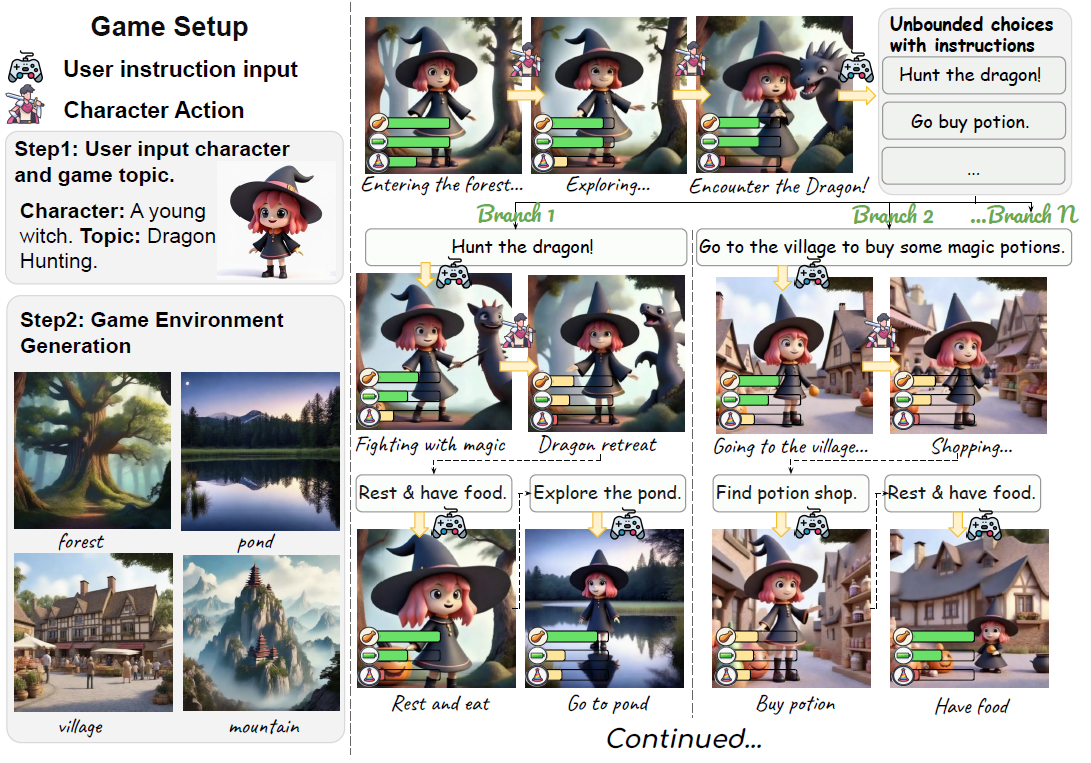In an article recently submitted to the arXiv preprint server, researchers presented a groundbreaking game called Unbounded. This generative infinite game leveraged generative artificial intelligence (AI) to create an open-ended character life simulation.
Inspired by the concept of infinite games, first defined by James P. Carse, Unbounded used a specialized large language model (LLM) for dynamic gameplay mechanics and an innovative image prompt adapter for consistent visual generation. The game offered interactive, emergent experiences, which were evaluated to show improvements in narrative coherence, user interaction, and visual consistency compared to traditional simulation games.
Background
The concept of infinite games, introduced by James P. Carse, refers to games designed for endless play, with evolving rules and no fixed endpoints, contrasting with finite games with specific objectives and boundaries. Due to limitations in traditional game programming and pre-coded visuals, most video games have historically followed the finite game model. However, recent developments in generative AI, especially LLMs and visual generation models, now make it possible to transcend these limitations, enabling a truly generative infinite game experience.
In response to these advancements, this paper introduced Unbounded, a novel character life simulation game that implemented a generative infinite game framework. Inspired by sandbox, pet simulations, and tabletop role-playing games, Unbounded used generative AI to dynamically create game mechanics, narratives, and scenarios. The game featured a specially trained LLM that generated gameplay mechanics, world scenarios, and ongoing character interactions in real time.
It included a specialized LLM for real-time gameplay generation and a regional image prompt (IP)-adapter with a unique “block-drop” feature for consistent character and environment visuals. This setup allowed for real-time interaction and open-ended play, adapting continuously to player choices. By addressing limitations in existing generative models, the paper demonstrated Unbounded's potential to advance interactive entertainment and pioneered a new foundation for research in AI-driven gaming.
Real-Time Generative Gameplay Method
Unbounded was an innovative generative game powered by advanced language and image generation models that introduced the concept of an infinite game with personalized, dynamic interactions. The game enabled users to create unique characters with distinct appearances and personalities, set within a continuously evolving world that players explored using natural language interactions.

Example of UNBOUNDED. Based on an initial user input, UNBOUNDED sets up game simulation environments, and generates character actions in the environments. Users can interact with the character with natural language instructions, exploring the game with unlimited options.
Key components included Latent Consistency Models (LCM) for high-speed, consistent character generation, using a streamlined approach with DreamBooth that reduced diffusion steps to personalize characters more efficiently. A unique regional IP adapter integrated characters seamlessly into environments, and the block-drop innovation in the IP adapter prevented character and environment interference.
A two-agent LLM system supported the game's character simulation. One LLM managed world-building, narrative progression, and state tracking, while the other simulated user interactions, enabling open-ended player choices that shaped the gameplay. To support real-time interactions, Unbounded distilled the capabilities of larger LLMs into a smaller, faster model called Gemma-2B, fine-tuned on thousands of synthetic samples. This approach allowed Gemma-2B to manage complex character life simulations while achieving performance comparable to larger models. Unbounded’s advancements presented a groundbreaking framework for AI-driven, generative, and interactive gaming experiences, filling gaps in personalized, infinite gameplay through robust character and environment consistency and responsive game mechanics.
Experimental Setup and Results
The experimental setup evaluated an advanced image generation model for the Unbounded game, focusing on three aspects: environment consistency, character consistency, and semantic alignment with text prompts. Using a dataset of 5,000 (character, environment, prompt) triplets, the researchers assessed performance across 100 diverse environments with various characters, including a dog, cat, and wizard.
They employed contrastive language–image pre-training (CLIP)-I, DINO, and DreamSim to measure environment and character consistency, complemented by CLIP-T to check prompt alignment. To ensure the character was always present in images, Grounding-DINO was applied to detect character presence, addressing the character-centric nature of the gameplay.
Image generation employed the Stable Diffusion XL (SDXL) model with DreamBooth low-rank adaptation (LoRA) for character embedding, supported by an IP-adapter for dynamic environment encoding. The dynamic masking feature in the IP adapter was adjusted to preserve image fidelity, ensuring high detail retention in both character and environment visuals.
The authors simulated 100 user interactions for LLM evaluation to test response accuracy in character state updates, environment relevance, story coherence, and prompt following. The LLM, based on the distilled Gemma-2B model and distilled with 5,000 synthetic interactions generated by two stronger LLMs, demonstrated enhanced simulation capabilities. Comparisons with other methods indicated that this approach achieved superior environment and character consistency, with notable improvements in character alignment.
Ablation studies revealed that the regional IP-Adapter with block drop yielded improved consistency and text alignment while maintaining semantic accuracy across prompts. Additionally, qualitative analysis confirmed the model's capacity to integrate characters seamlessly within the environment, supporting dynamic user interactions effectively.
Conclusion
In conclusion, Unbounded represented a pioneering step in interactive generative infinite games, leveraging advanced AI models to create a dynamic character life simulation. By integrating a specialized, distilled LLM for real-time interactions and employing a regional IP-adapter with block-drop innovation for consistency across diverse environments, Unbounded offered seamless gameplay with coherent narratives and sustained character consistency.
This innovative approach not only addressed the limitations of traditional finite games but also set the stage for future advancements in AI-driven gaming experiences, promoting personalized and emergent gameplay that evolves with player choices.

 *Important notice: arXiv publishes preliminary scientific reports that are not peer-reviewed and, therefore, should not be regarded as definitive, used to guide development decisions, or treated as established information in the field of artificial intelligence research.
*Important notice: arXiv publishes preliminary scientific reports that are not peer-reviewed and, therefore, should not be regarded as definitive, used to guide development decisions, or treated as established information in the field of artificial intelligence research.